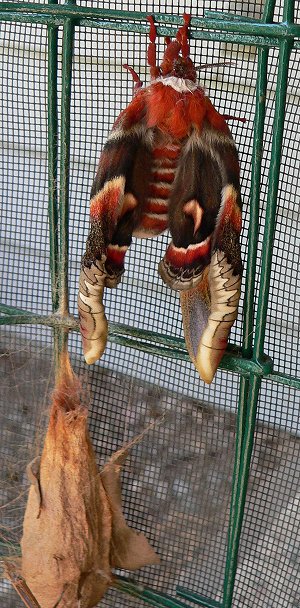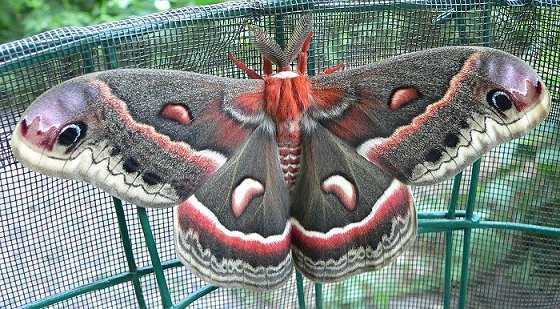All 6 of my remaining Cecropia moths hatched in the last few days. There was one male, and 5 females – I released the male and had lots of success attracting mates for the females.
Here’s a picture of one of the moths just after emerging. It’s wings are still limp and wilted looking. In about 15 minutes it pumps them up so they are big and firm. Just below is the cocoon it emerged from.

Here’s the male – notice his feathery antennae. That’s the only way I could tell the males and females apart. (Females have much slimmer antennae.) The males tend to be a bit smaller, and their bodies are less plump, but those differences are more subtle.

The first try was in town. Two females had hatched that day, so I put them in screen covered cages on the back porch for the night. I checked in the evening but didn’t see any males. I checked again at about 4am, and still no males. I was feeling a little discouraged, and wondered if this was ever going to work. At about 4:20am I was in bed, right below the edge of the porch, and Shadow the cat was sitting at the window. All of a sudden his head started swiveling back and forth as though he was watching something up by the porch. When I got upstairs, there were two male moths fluttering around the porch. As I sat and watched, more males came in, until there were six! I captured one and put it into a cage. It flapped for a while, and flew all around her, but after about 3 minutes, it settled in to mate.
The other female was on a bunch of lilac stems that were in a jar – the remains of the branches that she’d eaten as a caterpillar. I lifted the cage off so the males could get closer. All the unmated males went into a frenzy of flapping and banging into the windows and the screen of the cages. It seemed like the noise and motion was part of a ritual. Eventually one male dove in and started mating. Immediately two other males dove in right on top and started flapping their wings wildly. After a few minutes the other two males gave up and flew away, and everything quieted down.
It was such an exciting and mysterious thing to see in the early morning dusk.
These two couples stayed mated all day, and that night, when they came apart, I released them go at the farm.
The next try to attract males was at the farm. One female had hatched, so I put her (in her cage) on a chair next to the window of the screened porch. I was hoping more than two males would show up, because I wanted to know if there were already Cecropias living on our land (I had released the two mated males and females earlier in the evening.) Again, I didn’t see any moths that evening, but the next morning at about 4:30 the males started arriving. I put one in the cage with her, and there were 4 more circling around, flapping against everything. She successfully mated with the one in the cage, the frenzy was over, and the 4 unsuccessful males fluttered away.
The last morning – still at the farm – I had two females that had hatched the previous day. At about 4:20am I saw a moth hovering around the screen. I took the cage outside and opened the top. (The females don’t move at all during the whole mating ritual – they just wait.) The males were a little more subdued that morning – it could have had something to do with all the bats that were flying around above the house. But several of them did fly in, and with hardly any flapping and fluttering, two of them flew into the cage and started mating.
I had put two bunches of lilacs in the cage with the first two females, and they laid 20 or 30 eggs, so I have plenty to continue this next year. It’s been a wonderful experience.
Here’s a mating pair.

It was difficult to take their picture because they moved their wings slowly back and forth when I come close. I think it must be a defense mechanism. They are also able to squirt a liquid – which I think must also be for defense. They can aim fairly accurately, and can squirt it at least a foot and a half.
